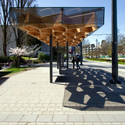
-
Architects: Public Architecture + Design
- Area: 120 m²
- Year: 2013
-
Photographs:Krista Jahnke

Text description provided by the architects. The UBC campus is full of holes. Some are below ground where construction sites pepper nearly every corner of campus. Some are at grade where the historic figure ground is a mixed bag of building forms, dead-ends and disjointed academic neighborhoods. Some are higher up still, off the ground -- floating in the tree canopy.



















